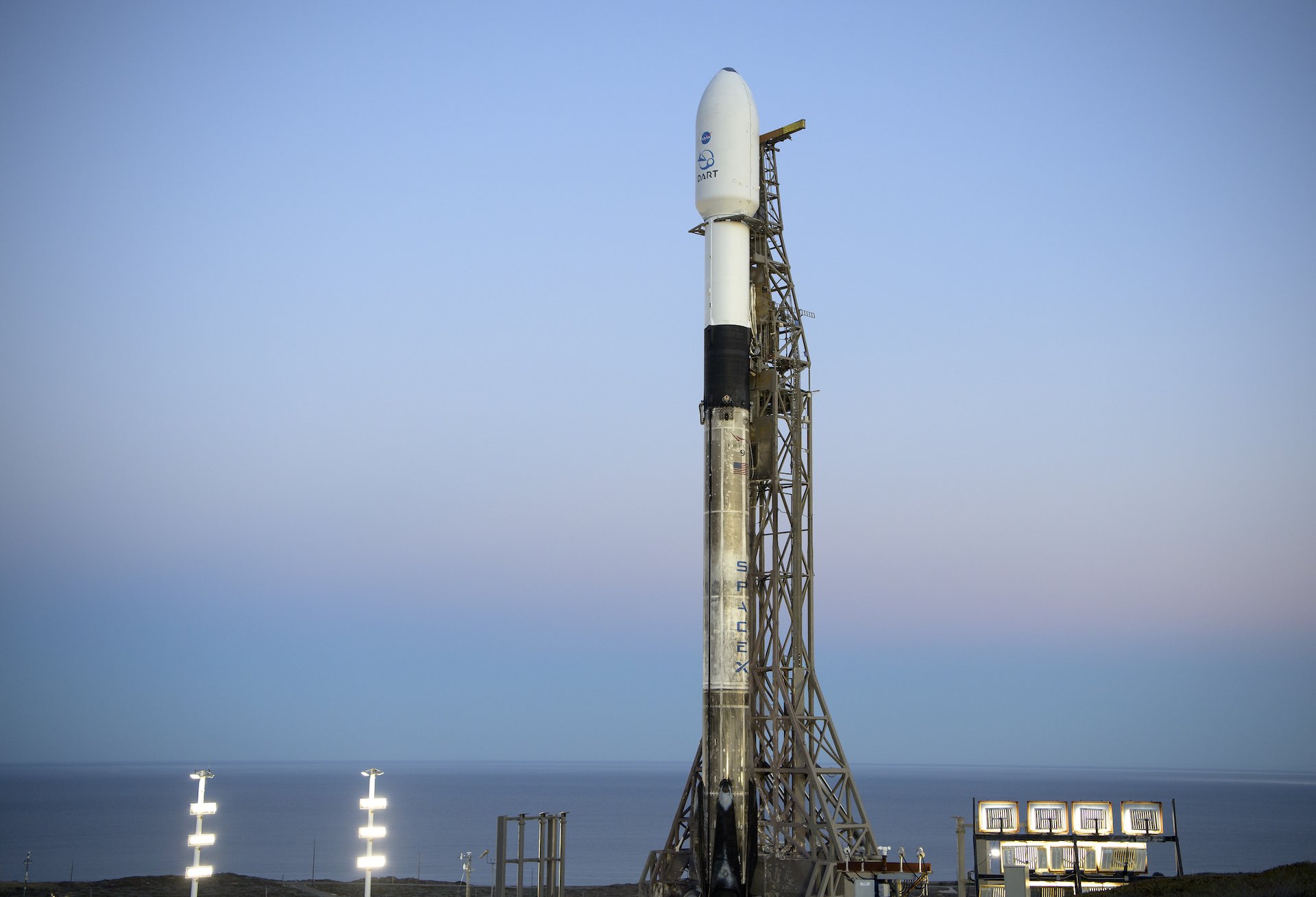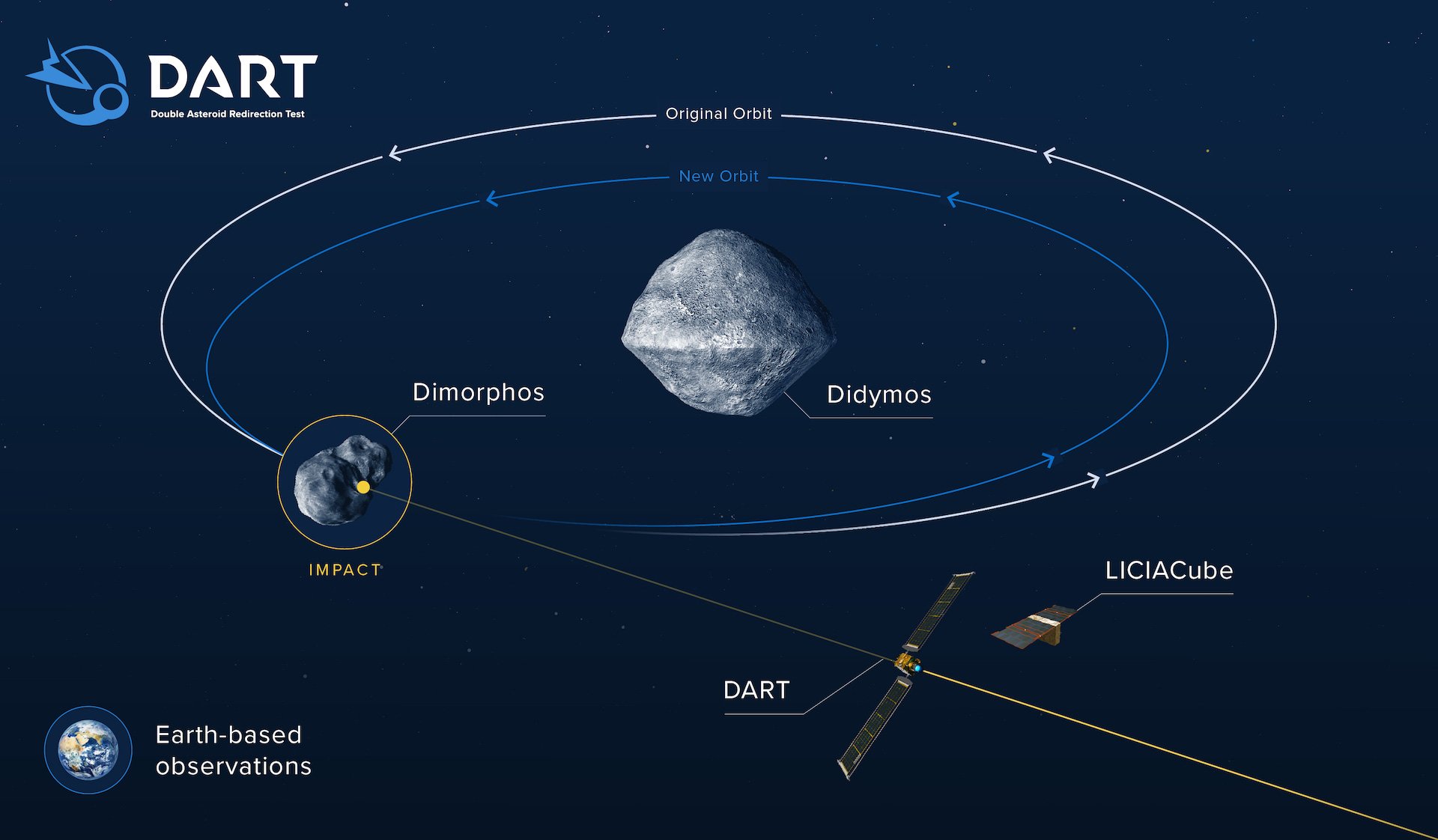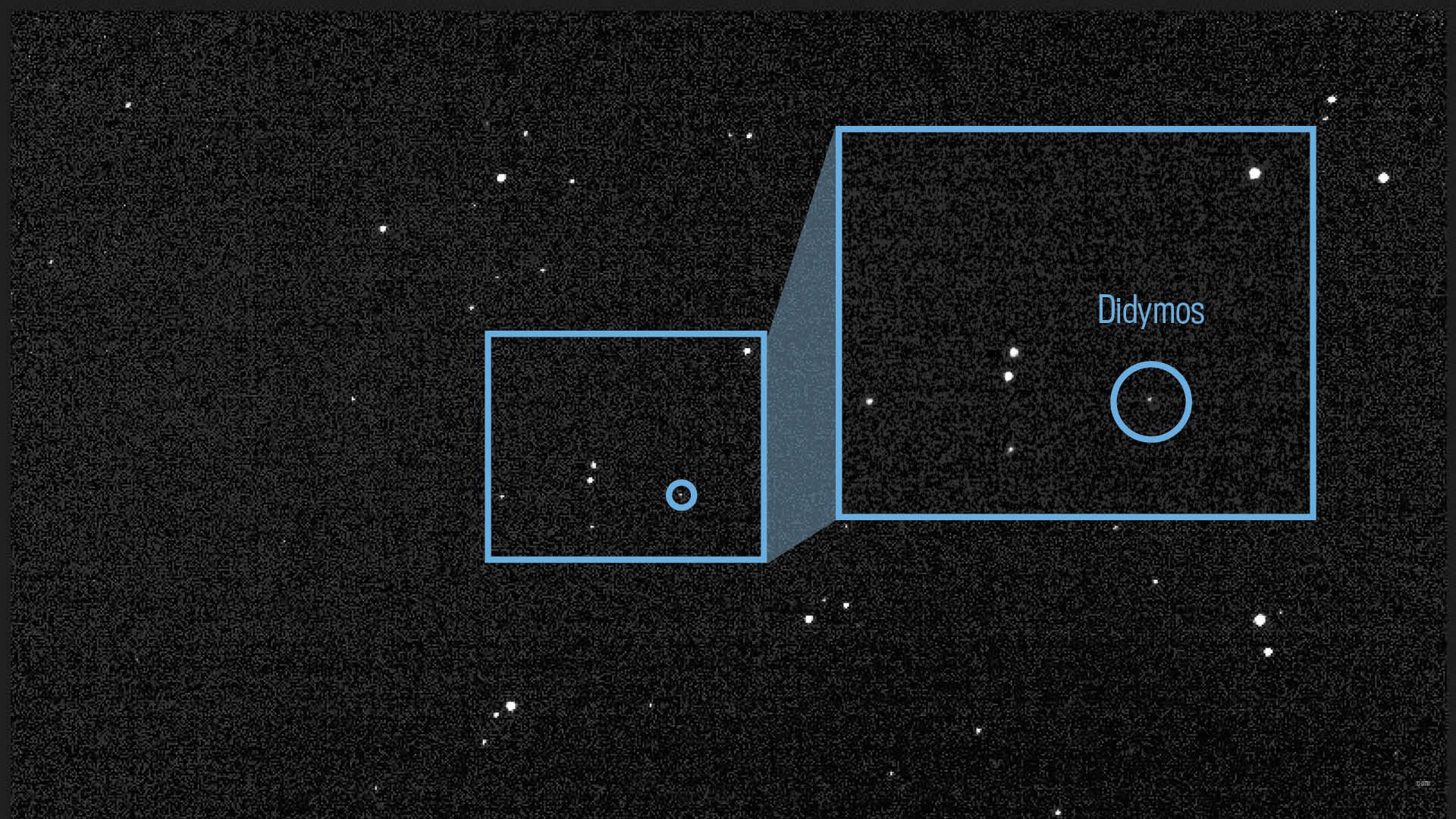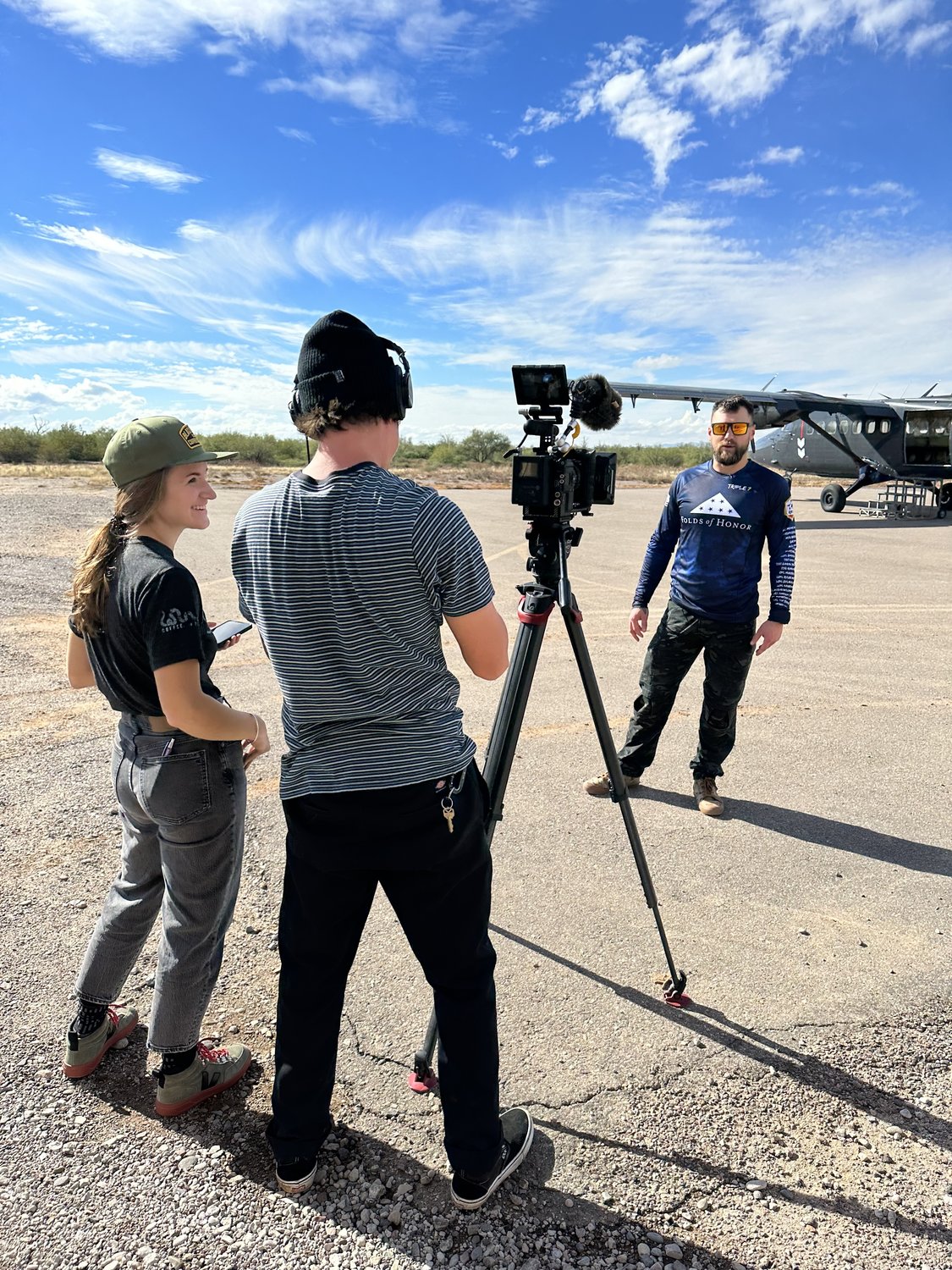An Asteroid Killed the Dinosaurs. NASA’s DART Mission May Be How We Stop the Next One

Illustration of DART spacecraft from behind by NASA/Johns Hopkins APL.
The dinosaurs never had a chance. But as of next week, maybe we will.
A NASA spacecraft moving at 4 miles per second will slam into an asteroid Monday, Sept. 26, a little after 7 p.m. Eastern Time. The pre-planned interception will be the first attempt by humans to shove a space object off its course and demonstrate the ability to deflect an asteroid hurtling toward Earth.
The Double Asteroid Redirection Test, or the DART mission, led by the Johns Hopkins Applied Physics Laboratory, or APL, for NASA, will test planetary defense. A NASA press release calls the intercept “kinetic impact deflection,” but picture it this way: They’re going to shoot an asteroid the size of the Washington Monument with a bullet the size of a vending machine.
Dr. Terik Daly, a planetary scientist on the DART mission team at Johns Hopkins APL, talked to Coffee or Die Magazine about the purpose of the mission.

The SpaceX Falcon 9 rocket with the Double Asteroid Redirection Test, or DART, spacecraft onboard, is seen during sunrise, Tuesday, Nov. 23, 2021, at Space Launch Complex 4E, Vandenberg Space Force Base in California. NASA photo by Bill Ingalls.
“If, one day, for example, we were in a situation where we’re planning how to respond to an asteroid we thought posed a hazard to Earth, we want to know, ‘How much of a shove do we have to give that asteroid to move it out of the way?’” Daly said.
A SpaceX rocket launched the DART spacecraft from Vandenberg Space Force Base, California, on Nov. 23, 2021.
The DART space bullet will crash into an asteroid known as Dimorphos, a 535-foot-wide asteroid that orbits Didymos, a larger asteroid that orbits the sun.
Scientists picked Dimorphos as a target, Daly said, because of its entwined orbit with Didymos, which scientists call a binary asteroid system.
It’s safer that way.

Infographic showing the effect of DART's impact on the orbit of Dimorphos by NASA/Johns Hopkins APL.
“We’re aiming this test at this binary asteroid system, so we don’t accidentally send an asteroid towards the Earth,” Daly said.
Because Dimorphos orbits another asteroid, speeding Dimorphos up will change its path around Didymos, but it won’t change Didymos’ orbit around the sun.
“When you’re driving a car, you hope you’re never going to have a car crash, but you want to know your airbags work, right?” Daly said. “We want to do this test, but we want to test this technology in a way that does not pose a hazard to Earth.”
Scientists suggest an asteroid about 10 kilometers wide — roughly 60 times larger than Dimorphos — struck Earth 66 million years ago, wiping out as much as 75% of the species on Earth, including the dinosaurs.
NASA tracks a wide range of asteroids around the Earth, some of which could be dangerous, Daly said, though none pose an immediate threat.

Composite of 243 images taken by DRACO on July 27, 2022, detecting Didymos by JPL DART Navigation Team.
“The really large asteroids — think, like, dinosaur killer — we know where all of those are, we’re not worried about those, right? Asteroids the size of, like, you know, a Toyota Corolla — lots of those — we don’t care because they burn up in the atmosphere, right?” Daly said.
Asteroids more than 460 feet wide, like Dimorphos, could wipe out metropolitan areas if they hit Earth, Daly said. In all, NASA astronomers estimate there are 25,000 near-Earth asteroids close to that size.
“We don’t know of any asteroids coming our way for at least the next 100 years,” Daly said. But astronomers are only aware of about 40% of asteroids large enough to cause regional devastation, he said.
“That’s a cause for concern. If we don’t know what’s out there, we can’t prepare for it terribly well,” Daly said. “Congress passed a law, actually, that said that NASA needs to find 90% of all the near-Earth asteroids 140 meters [or 500 feet] and larger. That hasn’t happened yet. NASA is working on it.”
The University of Arizona and the Jet Propulsion Laboratory at the California Institute of Technology are working toward the goal. Scientists will next launch a telescope, dubbed the Near-Earth Object Surveyor, Daly said, that “has one job and one job only, which is to look for asteroids that may come near the Earth.”

DART team engineers lift and inspect the LICIACube CubeSat after it arrived at Johns Hopkins APL in Aug. 2021. Johns Hopkins APL photo by Ed Whitman.
DART’s final path to impact will begin when the ship is about 56,000 miles from its target. Over the next four hours, DART will autonomously home in on Dimorphos using its onboard guidance system, known as Small-Body Maneuvering Autonomous Real Time Navigation, or SMART Nav.
“When this spacecraft is going 4 miles a second, and it’s got to hit something that’s the size of a giant Ferris wheel, we can’t be, like, joy-sticking it from the ground,” Daly said. “So the aircraft actually guides itself to hit the asteroid.”
Scientists timed the test to catch Dimorphos at its closest pass to Earth, about 6.7 million miles away.
As a result, the DART mission team will be able to observe the impact and its aftermath with telescopes. Right now, Dimorphos orbits Didymos about once every 12 hours, Daly said. The DART spacecraft is expected to shift that orbital period by several minutes.
The Didymos Reconnaissance and Asteroid Camera for Optical Navigation, or DRACO, a high-powered camera on board DART, will take onboard photos until impact, which will destroy the spacecraft.
Meanwhile, the Light Italian CubeSat for Imaging of Asteroids, or LICIACube, a small satellite that hitched a ride on the DART spacecraft until breaking away on Sept. 12, will photograph the crash from nearby.
“Success means, No. 1, we hit the asteroid,” Daly said. "If you think of shooting a rifle at something, you get a bunch of debris knocked up, right? And, if there’s a lot of that debris, it kind of acts a bit like a rocket engine and actually gives the asteroid more of a shove than it would with just the spacecraft.”
The direct impact is one of three methods Daly said might be able to move an asteroid off course.
“Another is called gravity attractor, which, if you kind of think of taking a spacecraft, going and putting it next to an asteroid for a while, and a little gravitational tug of that spacecraft over a period of decades can change the orbit of the asteroid,” Daly said. “And the other options involve nuclear devices, and those have not been tested that I have heard.”
Read Next: Rockets and Space Planes Could Deliver Troops to Battlefields in Hours

Jenna Biter is a staff writer at Coffee or Die Magazine. She has a master’s degree in national security and is a Russian language student. When she’s not writing, Jenna can be found reading classics, running, or learning new things, like the constellations in the night sky. Her husband is on active duty in the US military. Know a good story about national security or the military? Email Jenna.
BRCC and Bad Moon Print Press team up for an exclusive, limited-edition T-shirt design!
BRCC partners with Team Room Design for an exclusive T-shirt release!
Thirty Seconds Out has partnered with BRCC for an exclusive shirt design invoking the God of Winter.
Lucas O'Hara of Grizzly Forge has teamed up with BRCC for a badass, exclusive Shirt Club T-shirt design featuring his most popular knife and tiomahawk.
Coffee or Die sits down with one of the graphic designers behind Black Rifle Coffee's signature look and vibe.
Biden will award the Medal of Honor to a Vietnam War Army helicopter pilot who risked his life to save a reconnaissance team from almost certain death.
Ever wonder how much Jack Mandaville would f*ck sh*t up if he went back in time? The American Revolution didn't even see him coming.
A nearly 200-year-old West Point time capsule that at first appeared to yield little more than dust contains hidden treasure, the US Military Academy said.












